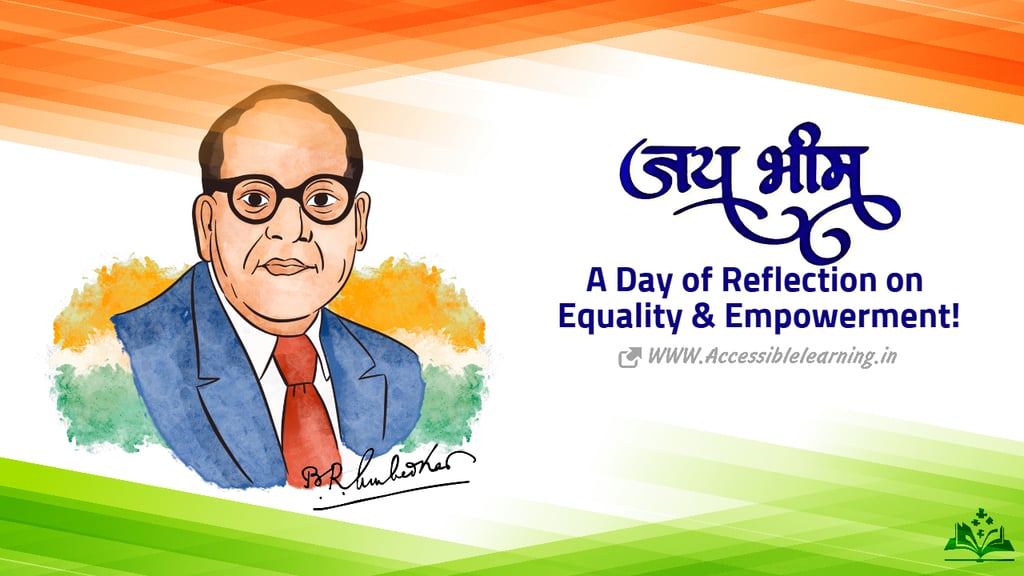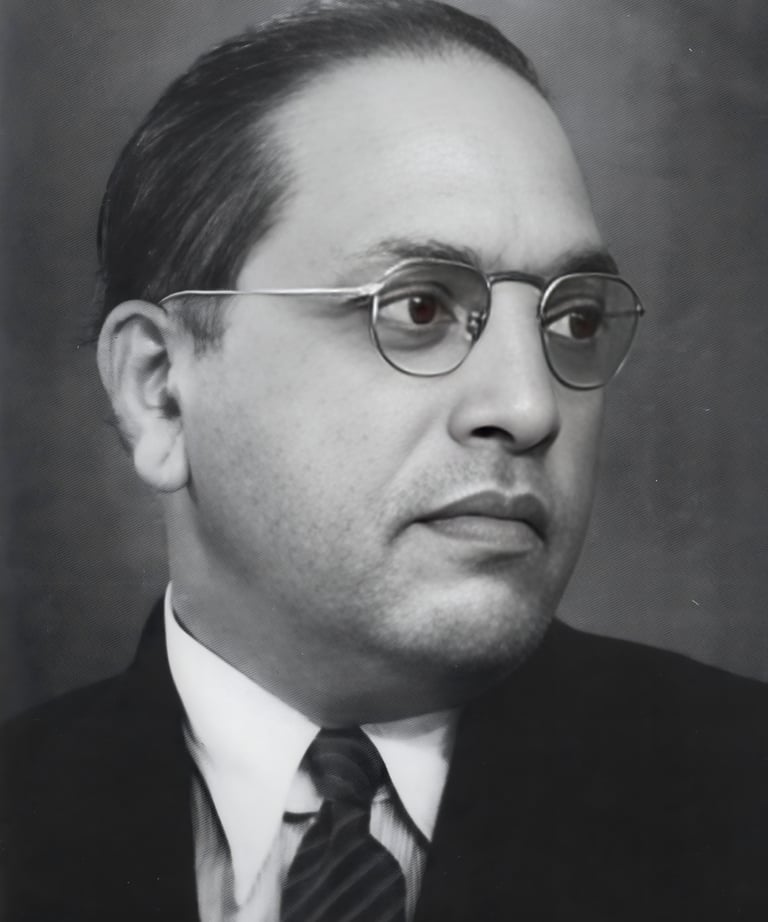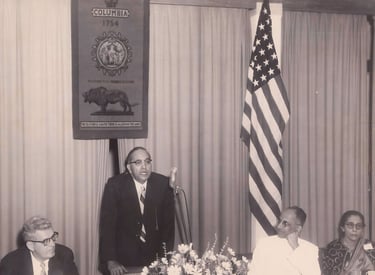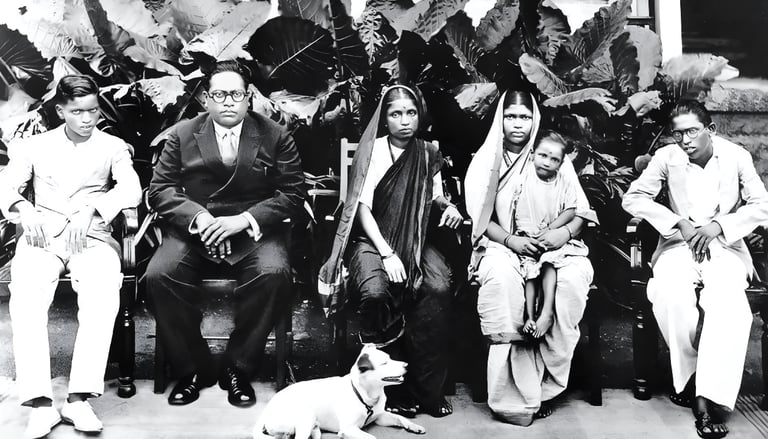
Dr. B.R. Ambedkar: Architect of India's Constitution and Champion of Social Justice
Dr. B.R. Ambedkar: A comprehensive exploration of the life, legacy, and enduring impact of India's constitutional architect and champion of social justice. Discover how his extraordinary journey from marginalization to prominence fundamentally reshaped Indian society and continues to inspire movements for equality worldwide.
BIOGRAPHY/HISTORYINDIA/BHARATEDUCATION/KNOWLEDGEBIOGRAPHY
Keshav Jha
4/7/202515 min read


Dr. Bhimrao Ramji Ambedkar Ji stands as one of India's most influential figures, whose contributions to social reform, constitutional law, and the fight against caste discrimination fundamentally transformed Indian society. Often referred to as Babasaheb, his journey from humble beginnings to becoming the chief architect of the Indian Constitution represents one of the most remarkable stories of intellectual triumph and social advocacy in modern history.
Early Life and Education: Overcoming Insurmountable Odds
Born on April 14, 1891, in Mhow, Madhya Pradesh, Ambedkar was the fourteenth child in a Mahar (Dalit) family. The Dalits, formerly known as "untouchables," faced severe discrimination under India's rigid caste system. During his childhood, Ambedkar experienced the cruel reality of untouchability firsthand—he was forced to sit separately in school, denied access to public water sources, and subjected to numerous humiliations that were commonplace for Dalits at that time.
In one particularly poignant incident from his childhood, Ambedkar and his siblings were stranded in a railway station during a journey because no cart driver would transport them once their caste identity became known. When they finally managed to hire a cart by paying double the fare, they were required to drive it themselves while the driver walked alongside to avoid "contamination." Such experiences deeply influenced his understanding of social injustice and fueled his later advocacy.
Despite these challenges, Ambedkar's intellectual potential was recognized early. His father, Ramji Maloji Sakpal, who worked in the British Indian Army and had risen to the rank of Subedar-Major, prioritized education for his children. The family later moved to Bombay (now Mumbai), where Ambedkar's academic journey truly began. His father's position in the army and his own community's adherence to the teachings of Kabir, a 15th-century social reformer, provided Ambedkar with a slightly more amenable environment for educational pursuits compared to most Dalits of that era.
His academic brilliance became evident when he became the only untouchable enrolled at Elphinstone High School. Later, he made history by becoming one of the first untouchables to enter Elphinstone College, affiliated with the University of Bombay. His early education was supported by a scholarship from the Gaekwad ruler of Baroda, Maharaja Sayajirao III, who was known for his progressive views.
Ambedkar's educational journey is a testament to his extraordinary intellect and perseverance. He earned multiple advanced degrees from prestigious institutions worldwide:
Bachelor's degree from Elphinstone College, Bombay (1912)
Master's degree from Columbia University (1915)
Doctorate from Columbia University (1927) with his thesis "The Evolution of Provincial Finance in British India"
Law degree from Gray's Inn, London
Doctorate from the London School of Economics (1923) with his thesis "The Problem of the Rupee: Its Origin and Its Solution"
D.Sc. (Doctor of Science) in Economics from the London School of Economics (1923)
During his time at Columbia University, Ambedkar was deeply influenced by John Dewey, whose pragmatic approach to social problems and emphasis on education as a tool for social change resonated with him. He also studied under Edwin Seligman, a prominent economist who encouraged his interest in public finance. At the London School of Economics, he was mentored by distinguished scholars including Harold Laski, whose views on liberty and equality further shaped Ambedkar's political philosophy.
This extensive academic training equipped him with a profound understanding of economics, political science, law, and social theory—knowledge he would later deploy in his fight for social justice and constitutional reform.


Crusade Against Caste Discrimination
Ambedkar's return to India marked the beginning of his lifelong mission to eradicate the caste system. Upon returning with his foreign degrees, he faced the stark reality that his educational achievements did not shield him from caste discrimination. Despite being appointed as military secretary to the Maharaja of Baroda, he encountered hostility from colleagues who refused to share water or files with him, ultimately forcing him to leave the position.
He believed that political empowerment of the oppressed was essential for meaningful social reform. In 1924, he founded the Bahishkrit Hitakarini Sabha (Outcastes Welfare Association) with the slogan "Educate, Agitate, Organize." This organization worked to promote education among untouchables, improve their economic status, and represent their grievances before government bodies.
One of his most iconic acts of defiance occurred in 1927, when he led the Mahad Satyagraha, where he and his followers drank water from the Chavadar public tank to assert their right to access public resources. The act, though seemingly simple, was revolutionary in challenging the notion that untouchables' presence could "pollute" water used by upper castes. Following this, he publicly burned copies of the Manusmriti (an ancient legal text that codified the caste system), symbolically rejecting religious sanctions for social inequality.
His advocacy extended beyond symbolic protests. He established newspapers like Mooknayak (Leader of the Voiceless) in 1920 and Bahishkrit Bharat (Excluded India) in 1927 to raise awareness about caste injustice. Through these platforms, he articulated his vision for a more equitable society based on the principles of liberty, equality, and fraternity.
In 1936, Ambedkar founded the Independent Labour Party, which secured 15 seats in the 1937 Bombay elections. Through this political platform, he advocated for workers' rights and policies to uplift marginalized communities. His advocacy in the Bombay Legislative Assembly included pioneering legislation on issues ranging from agricultural indebtedness to maternity benefits for women workers.
Ambedkar's approach to social reform was multifaceted. He recognized that true emancipation required not just legal protections but also economic independence and educational advancement. He established institutions like the People's Education Society in 1945, which founded several colleges including Siddharth College in Bombay and Milind College in Aurangabad, creating educational opportunities for Dalit students.
His critique of the caste system was not merely political but also deeply intellectual. In works like "Annihilation of Caste" (1936), which was originally prepared as a speech for the Jat-Pat Todak Mandal (Society for the Abolition of Caste), he provided a comprehensive critique of the philosophical and religious underpinnings of the caste system. The organization ultimately canceled his invitation upon reviewing his radical ideas, but Ambedkar published the text independently. The work remains one of the most incisive analyses of caste as a system of graded inequality enforced through religious sanctions.


Political Career and Constitutional Contributions
Ambedkar's political career gained significant momentum during India's struggle for independence. While he supported the cause of freedom, he insisted that political independence would be meaningless without social liberation for all Indians, particularly the marginalized communities.
In 1930 and 1931, Ambedkar attended the Round Table Conferences in London, where he advocated for separate electorates for untouchables. This position brought him into direct conflict with Mahatma Gandhi, who feared that separate electorates would divide Hindu society and permanently segregate untouchables. Gandhi's subsequent fast in protest led to the Poona Pact of 1932, where Ambedkar agreed to joint electorates with reserved seats for untouchables instead of separate electorates.
His political philosophy sometimes diverged from other independence leaders, particularly Mahatma Gandhi. While both sought to uplift Dalits, their approaches differed: Gandhi advocated reformation of the caste system from within Hindu traditions, while Ambedkar believed more radical measures were necessary to dismantle entrenched social hierarchies. Despite these differences, both leaders maintained mutual respect, recognizing each other's commitment to India's betterment.
In 1942, Ambedkar founded the Scheduled Castes Federation, further advancing his political advocacy for Dalit rights. His growing political influence led to his appointment as a Labour Member in the Viceroy's Executive Council from 1942 to 1946, where he worked on labor policies and infrastructure development.
After independence, Ambedkar was invited by Jawaharlal Nehru to join the new government as India's first law minister. His acceptance of this role demonstrated his commitment to working within the democratic system to effect change, despite his earlier critiques of Congress leadership.
Architect of the Indian Constitution
Ambedkar's most enduring contribution came when he was appointed as the Chairman of the Constitution Drafting Committee in 1947. His legal expertise, combined with his firsthand experience of social inequality, made him uniquely qualified for this monumental task.
The drafting process was exhaustive, involving review of constitutions from around the world, extensive debates in the Constituent Assembly, and careful consideration of India's unique social and political challenges. Ambedkar's committee examined over 50 constitutions from different countries to craft a document suited to India's diverse needs.
The Indian Constitution, adopted on January 26, 1950, reflected Ambedkar's vision of a democratic society founded on justice, liberty, equality, and fraternity. It explicitly prohibited discrimination based on caste and included provisions for affirmative action to ensure representation of historically disadvantaged groups.
Some key constitutional provisions championed by Ambedkar include:
Article 17, which abolished untouchability and made its practice in any form a punishable offense
Articles 15 and 16, which prohibit discrimination on grounds of religion, race, caste, sex, or place of birth
Article 32, which guarantees the right to constitutional remedies, which Ambedkar described as the "heart and soul of the Constitution"
Provisions for reservations in educational institutions and government jobs for Scheduled Castes and Scheduled Tribes
The directive principles of state policy, which established social and economic goals for the Indian state
Ambedkar's constitutional framework established not merely a political system but a social manifesto aimed at transforming Indian society. As he eloquently stated during his final address to the Constituent Assembly on November 25, 1949: "Political democracy cannot last unless there lies at the base of it social democracy. What does social democracy mean? It means a way of life that recognizes liberty, equality, and fraternity as the principles of life."
In this historic speech, he also warned, "We are going to enter into a life of contradictions. In politics we will have equality, and in social and economic life we will have inequality... We must remove this contradiction at the earliest possible moment, or else those who suffer from inequality will blow up the structure of political democracy that this Assembly has so laboriously built up."
Religious Conversion and Later Years
Even while serving as Law Minister, Ambedkar continued to advocate for Hindu Code Bills, which aimed to reform Hindu personal laws related to marriage, divorce, inheritance, and adoption. These bills sought to provide greater rights to women and challenge patriarchal aspects of traditional Hindu law. His progressive stance on women's rights was evident in his insistence that the reformed code should include provisions for divorce and women's inheritance rights, positions that were controversial at that time.
When faced with significant opposition to these reforms, Ambedkar resigned from the cabinet in 1951, demonstrating his unwillingness to compromise on principles of equality and justice. In his resignation speech, he expressed deep disappointment at the resistance to measures he considered essential for women's emancipation and social progress.
Ambedkar's disillusionment with Hinduism, which he viewed as inherently hierarchical, led him to explore alternative spiritual paths. After extensive study of various religions, he embraced Buddhism in 1956, believing its emphasis on equality aligned with his vision of social justice.
His interest in Buddhism had developed over decades of scholarly engagement with religious texts. He was particularly drawn to Buddhism's rejection of caste distinctions and its emphasis on reason rather than blind faith. In 1950, he published "Buddha and His Dhamma," a comprehensive reinterpretation of Buddhist teachings that emphasized their social and ethical dimensions.
In a historic ceremony in Nagpur on October 14, 1956, Ambedkar converted to Buddhism along with approximately 500,000 followers. Before the conversion, he took 22 vows, which included renunciations of Hindu deities and practices along with commitments to follow the Buddha's path and work for the welfare of humanity. This mass conversion represented not just a religious shift but a social revolution—a collective rejection of a system that had perpetuated inequality for centuries.
Just six weeks after this momentous event, on December 6, 1956, Ambedkar passed away in his sleep at his home in Delhi. His last major work, "The Buddha and His Dhamma," was published posthumously and outlined his interpretation of Buddhist teachings. His funeral in Bombay was attended by hundreds of thousands of mourners, testifying to his profound impact on Indian society.


Literary & Scholarly Contributions
Throughout his life, Ambedkar produced a remarkable body of written work that combined rigorous scholarship with passionate advocacy. His writings span economics, politics, history, religion, and social theory, representing one of the most comprehensive intellectual engagements with India's social problems.
Some of his most significant works include:
"Castes in India: Their Mechanism, Genesis, and Development" (1916): His first scholarly paper, presented at an anthropology seminar at Columbia University, providing an early analysis of the origins and function of the caste system.
"The Problem of the Rupee: Its Origin and Its Solution" (1923): His doctoral thesis at the London School of Economics, examining India's currency problems under British rule.
"Annihilation of Caste" (1936): Perhaps his most famous work, offering a comprehensive critique of the caste system and arguing for its complete eradication rather than reform.
"Pakistan or the Partition of India" (1940): A detailed analysis of the political and social implications of creating a separate Muslim state.
"What Congress and Gandhi Have Done to the Untouchables" (1945): A critical examination of the nationalist movement's approach to caste issues.
"States and Minorities" (1947): A memorandum proposing constitutional safeguards for disadvantaged communities.
"The Buddha and His Dhamma" (1957, posthumous): His reinterpretation of Buddhist philosophy emphasizing its social and ethical dimensions.
"Revolution and Counter-Revolution in Ancient India" (posthumous): An analysis of ancient Indian history through the lens of social conflict between Buddhism and Brahminism.
Ambedkar's writings are characterized by their analytical rigor, historical depth, and moral clarity. He combined Western liberal and Marxist critiques with indigenous perspectives to develop a unique theoretical framework for understanding and addressing social inequality.
Legacy: The Continuing Relevance of Ambedkar's Vision
Nearly seven decades after his death, Ambedkar's influence pervades contemporary Indian society. His constitutional framework continues to guide India's democratic journey, while his advocacy for social justice inspires ongoing movements against discrimination.
The implementation of reservations (affirmative action) for Scheduled Castes, Scheduled Tribes, and Other Backward Classes in education and government employment—policies that have enabled millions from marginalized communities to access opportunities previously denied to them—can be traced directly to Ambedkar's constitutional vision.
His influence extends beyond formal policies to social movements. The Dalit Panthers, formed in the 1970s, drew inspiration from Ambedkar's writings in their fight against continuing caste oppression. Contemporary Dalit activists and intellectuals continue to engage with his ideas, often using his work as a theoretical foundation for addressing persistent social inequalities.
Ambedkar's statues stand prominently across India, and his portrait adorns the central hall of Parliament—a fitting tribute to the man who ensured that democracy in India would not be merely a system of governance but a vision of social equality. His former residence in London, where he stayed while studying at LSE, was purchased by the Maharashtra government in 2015 and converted into a memorial-museum.
His birthday, April 14, is commemorated as "Ambedkar Jayanti" and is an official public holiday in India. Educational institutions, public buildings, and infrastructure projects across the country bear his name, ensuring that future generations remember his contributions. The Ambedkar International Center in New Delhi serves as a research institution dedicated to studying and promoting his ideas.
Beyond these formal recognitions, Ambedkar's most significant legacy lies in the consciousness he awakened among marginalized communities. By demonstrating that social barriers could be overcome through education and organized political action, he provided a blueprint for empowerment that continues to inspire social movements worldwide.


Intellectual Contributions Beyond Constitutional Law
While Ambedkar is primarily known for his constitutional expertise and social activism, his intellectual contributions extended to various fields. He wrote extensively on economics, publishing scholarly works including "The Problem of the Rupee: Its Origin and Its Solution" (1923) and "The Evolution of Provincial Finance in British India" (1925).
As an economist, Ambedkar was particularly concerned with issues of public finance, monetary policy, and land reform. His doctoral research at the London School of Economics critically examined the gold exchange standard implemented in India by the British, arguing that it disadvantaged the Indian economy. He advocated for a managed currency system that would better serve India's developmental needs.
On land reform, Ambedkar proposed collective farming as a solution to rural inequality. In his 1918 paper "Small Holdings in India and Their Remedies," he argued that the fragmentation of landholdings was economically inefficient and perpetuated rural poverty. He suggested consolidation of land and cooperative farming as alternatives, ideas that influenced land reform policies in post-independence India.
His economic thinking emphasized the importance of industrialization, land reform, and state intervention to address inequality. In his memo "States and Minorities," submitted to the Constituent Assembly, he proposed that key industries, agriculture, and insurance should be owned and operated by the state. He believed that economic democracy was essential for the success of political democracy, a perspective that influenced India's early economic policies and continues to inform discussions about inclusive development.
Ambedkar also made significant contributions to religious and philosophical discourse. His critical examination of religious texts and practices reflected his belief that spiritual traditions should be evaluated based on their compatibility with reason and human dignity.
His engagement with Buddhism went beyond personal faith to scholarly reinterpretation. In "The Buddha and His Dhamma," he presented Buddhism as a rational ethical system focused on social justice rather than metaphysical speculation. This interpretation, sometimes termed "Navayana" or "Neo-Buddhism," emphasized aspects of Buddhist teaching that aligned with modern democratic values.
Ambedkar's Thoughts on Gender Equality
Ambedkar's vision of social justice extended beyond caste to encompass gender equality. He was a strong advocate for women's rights at a time when such positions were considered radical. In his writings and speeches, he consistently highlighted the intersectionality of caste and gender oppression, noting that Dalit women faced discrimination on multiple fronts.
His support for gender equality was most evident in his work on the Hindu Code Bill, which sought to give women rights to property, adoption, divorce, and protection from polygamy. During parliamentary debates on these bills, he argued, "The present condition of Hindu women is the product of a code that you have accepted, and it is surprising that those who approve of the Code should object to undertaking to remove the evils that it has produced."
His famous statement, "I measure the progress of a community by the degree of progress which women have achieved," reflects his understanding that true social justice cannot be achieved without addressing gender inequality. This perspective was revolutionary in pre-independence India and continues to influence contemporary feminist discourse in the country.
Ambedkar's Global Significance
Ambedkar's work transcends national boundaries. His critique of social hierarchies and advocacy for human rights resonate with marginalized communities worldwide. His methodology—combining scholarly analysis with practical activism—offers a model for social reformers facing entrenched systems of discrimination.
In recent decades, international recognition of Ambedkar's contributions has grown significantly. His statue has been installed at the London School of Economics and Columbia University, acknowledging his intellectual legacy. The United Nations has celebrated his contributions to social justice and human rights, with former UN Secretary-General Ban Ki-moon describing him as "a global champion of human rights."
His writings are studied in universities globally, and scholars increasingly acknowledge his place among the preeminent social theorists of the 20th century. His approach to addressing structural inequality through constitutional means provides valuable insights for societies grappling with similar challenges.
The international Dalit solidarity networks have drawn inspiration from Ambedkar's strategies of empowerment through education, political organization, and legal advocacy. His emphasis on constitutional remedies for historical injustices has influenced affirmative action policies in various countries.

Controversies and Criticisms
No assessment of Ambedkar's legacy would be complete without acknowledging the controversies surrounding some aspects of his work and the criticisms he faced. His critical stance toward Hinduism and his decision to convert to Buddhism alienated some Hindu nationalists, who saw his actions as divisive. His disagreements with Gandhi over separate electorates and approaches to untouchability created tensions within the independence movement.
Some scholars have critiqued his emphasis on legal and constitutional remedies, arguing that formal equality under the law has not translated into substantive social equality. Critics suggest that his focus on political and legal strategies may have underestimated the resilience of caste discrimination in social and economic spheres.
From another perspective, some radical Dalit activists have argued that Ambedkar's constitutional approach was too accommodating to existing power structures. They suggest that more revolutionary methods might be necessary to address deeply entrenched inequalities.
However, most serious scholars acknowledge that these critiques must be understood in the context of the immense challenges Ambedkar faced and the significant progress that has been made through the constitutional framework he established. His strategic decisions reflected a pragmatic assessment of what was achievable in the social and political context of his time, while still maintaining a radical vision of social transformation.
Ambedkar's life journey—from facing discrimination as a Dalit child to shaping India's constitutional democracy—represents one of history's most remarkable narratives of personal achievement and social impact. His intellectual rigor, moral courage, and unwavering commitment to justice enabled him to transform not just his own circumstances but the fundamental structures of Indian society.
His final speech to the Constituent Assembly contains what is perhaps his most enduring message: "We must make our political democracy a social democracy as well. Political democracy cannot last unless there lies at the base of it social democracy." This insight remains profoundly relevant in contemporary India and beyond.
The India that Ambedkar envisioned—where social equality matches political democracy—remains a work in progress. Caste discrimination, though legally prohibited, persists in various forms. Economic disparities continue to align substantially with historical social divisions. These ongoing challenges highlight the continuing relevance of Ambedkar's ideas and the unfinished nature of his mission.
As India navigates the complexities of the 21st century, Ambedkar's principles provide essential guidance. His emphasis on constitutional methods, education as a path to empowerment, and the necessity of both political and social democracy offers a comprehensive framework for addressing contemporary challenges.
In Ambedkar's own words: "Democracy is not merely a form of government. It is primarily a mode of associated living, of conjoint communicated experience. It is essentially an attitude of respect and reverence towards fellow men." This vision of democracy as a social ethic rather than merely a political system captures the essence of his legacy—a legacy that continues to inspire those working toward more just and equitable societies worldwide.
Subscribe To Our Newsletter
All © Copyright reserved by Accessible-Learning Hub
| Terms & Conditions
Knowledge is power. Learn with Us. 📚


